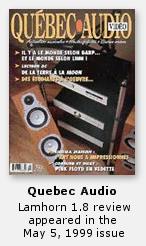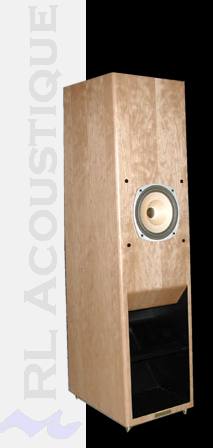| |
LAMHORN
1.8 ENCLOSURES
 By
Pascal Debien By
Pascal Debien
Translated by C. Phaneuf
In the world of Hi-Fi you sometimes come across surprising
pieces of equipment that make you question the credos and values
that conventional ‘market oriented’ wisdom has imposed
on you over the years. In this test bench, I was fortunate enough
to make an unforgettable discovery of an exceptional product : Acoustic
enclosures that break away from convention by using a single wide
band transducer in a very special design the Lamhorn 1.8.

Designed and built in Montreal by Robert Lamarre, these acoustic
enclosures are among a very small family of enclosures sharing the
back loaded horn principle of operation (see fig.2). This
type of enclosure is very popular in Europe and in Asia where many
clubs are actively promoting the concept. The philosophy behind
this enclosure is based on the premise that transparency and acoustic
purity are better when sound comes from a single source (the wideband
driver) and consequently, no cross-over circcuitry is needed.
Basic principles and conception of horn
loaded wide band enclosures
Fundamentally, there are two types of horn enclosures : Front
loaded (fig 1) and back loaded (fig. 2). This article deals with
the latter.
The function of the horn is to amplify all frequencies naturally,
as does the horn of a trumpet, or a saxophone. In a back loaded
enclosure, the back wave generated by the diaphragm of the transducer
is directed in the throat of the horn to be amplified. If low frequencies
are generated and if horn loading is matched, then these will be
amplified. This design makes it so that only fundamentals are reproduced,
without coloration. As an example, an enclosure designed to reproduce
40 Hz should, in theory, have a mouth opening circumference of 8,5
metres; that is : Mouth radius = speed of sound divided by 2 pi
times frequency. This would obviously result in an enclosure of
monster dimensions. To overcome the problem, and for practical reasons
(because the walls of the room reflect sound), designers produce
mouth circumferences that are a quarter wavelenght of the lowest
frequency to be reproduced. The resulting enclosures still have
large; but acceptable dimensions. It is possible to design horn
loaded enclosures using 1/8 th wavelength circumferences, provided
this enclosure is placed in a corner; but then the imaging capabilities
are reduced.
While the horn takes care of low frequencies, the wideband transducer
(front wave) takes care of medium and high frequencies. The lightweight
diaphragm takes care of medium frequencies, while the small center
(Whizzer) cone handles high frequencies. The brass centerpiece eliminates
phase cancellation.Wideband enclosures using a single transducer
have a flat impedance curve and do not use problem generating crossovers
or compensation circuits.
REPS R-1
High efficiency wideband transducers have been around for quite
a long time. The technology of coupling an ultralight diaphragm
to an ultra powerful motor dates back more than 60 years when Donald
Chave and Paul Voight created what was to become the famous Lowther
driver.
Francis Reps took over these basic principles in his own drivers.
The R-1 is powered by an 8 pound Alcomax-5 Magnet (aluminum, nickel,
cobalt) producing a magnetic field of 20 000 Gauss (The average
in a very good conventional transducer is typically around 14 000
Gauss) . The bobbin is made with a very rigid paper cylinder over
which lightweight aluminum wire is wound in such a manner as the
thickness never goes over 0,075 mm. This assembly is very light.
The bobbin is inserted in a 1 mm gap in the magnet.. The basket
is made using high quality Alcoa 356 aluminum. The diaphragm and
the whizzer cone are made with very stiff , lightweight German paper.
And small ribs are added for extra rigidity. Suspension is foam
material. A brass centerpiece (diffuser) is screwed in the magnet
centerpiece. Total cone excursion of the R-1 is ± 1 mm. Efficiency
of the R-1 is 99,8 dB/W/m and distortion at 100 dB is under 0,15
%.
Quality from head to toes
Lamhorn 1.8 enclosures are the result of three years of research
and development using several different prototypes. The back horn
length is 1,8 metre and the mouth opening is on the lower front
panel. The dimensions ( 127 cm H. x 33 cm W. x 43 cm D.) are reasonable,
considering the engineering concept used. They should be easy to
integrate in all kinds of environment. All corners have been rounded.
They weigh in at 66 kg each.
Very high density, high quality 17 ply 25 mm Brazilian birch plywood
has been used. Various finishes are available including oak and
rosewood. Internal wiring is Goertz with Cardas Silver binding posts.
Felt material is used internally for damping purposes. The placement
of damping material inside the enclosure is critical and designer
Robert Lamarre has told me that he had to experiment with over fifty
different positions for the placement of damping material before
finally finding the best position. Four brass tips are used to decouple
the enclosures from the floor. However, the master component in
the Lamhorn is without any doubt the wonderful wideband Reps R-1
driver. All components used in the Lamhorn are of exceptional quality,
much better than the usual standards.
Happiness and emotion
I first heard the Lamhorns in last year’s Montreal Sound
Festival. I was very impressed by their musicality. But this
time, meeting with the Lamhorns took place in our own listening
room at Quebec Audio. For sure, these heavyweights are difficult
to move. For listening tests, two different low power tube amplifiers
were used: a small 4 watt single ended integrated
amplifier, and a 15 watt OTL (tube amplifier without output transformer).
High efficiency (102 dB/w/m) enclosures like the Lamhorns do not
require monster amplifiers to perform which is contrary to commercially
available mainstream enclosures having a sensitivity in the 90 dB/w/m
range and requiring powerful amplifiers with lots of energy reserve
in order to handle dynamic transients. Two separate CD players were
used during listening tests.
Listening
Listening session began with Pergolesi’s Stabat Mater.
The intrinsic virtues of these enclosures lie in their ability to
reproduce almost perfectly all the subleties of a recording. Voices
of the singers are of exceptional purity, and can be easily separated
from the instrument group and the impression we get is that the
performance is close to perfection. Between the cuts on the CD,
one can hear clearly the echoes and reverberations of the place
where the recording sessions were made. No detail can escape us.
Listening to the Miserere by Gregorio Allegri leaves us with
an impression of outstanding realism that is seldom experienced.
This interpretation with 9 human voices is rendered with a perfection
that is incredibly close to reality : goosebumps… These Lamhorns
have a unique ability to reproduce perfectly the whole audio spectrum,
but especially the part comprising human voice where our hearing
is most sensitive.
I then proceeded with Toccata and Fugue in D minor by J.-S.
Bach. Organist André Isoir certainly plays with the same enthusiasm
as young Bach probably had when he made this composition. The Lamhorns
respond perfectly to all dynamic changes and the highest as well
as the lowest notes are rendered with such purity and transparence.
Maybe a very slight weakness in the very low end , but not much.
Conventional Hi-Fi enclosures are designed to reproduce the bass
by producing harmonics, rather than reproducing correctly the fundamental,
all of which produces artificial sonic coloration. But the Lamhorns
can reproduce with precision and exactitude the fundamentals, with
no coloration. I must confess to you that after listening to only
three cuts , my opinion about the performance of the Lamhorns was
already made. But I will continue to share with you the rest of
my impressions.
In Pictures at an exhibition by Modest Mussorgksky, the final
part Great door of Kiev gave us a surprise. This portion
is really loaded with musical emotion and there comes the part where
there is such a large number of instruments playing together that
very few acoustic enclosures can reproduce without losing details.
With the Lamhorns, I have for the first time clearly heard
a variety of subtle details that I never heard before. Now, how
about the unique sonority of the gong at the end What percussion
!!!. In the same line of thought, listening to traditional music
Sufi Mevlana on CD On the way to Bethleem allows one
to hear the fingers barely touching, and then hitting the skins
of the drums with a precision that can be qualified as surgical.
Finally, this listening session was completed with some jazz music,
here is an overview.
On Upper extremities by bassist Tony Levin and drummer Bill
Bruford, I could feel the thruthfullness in the attacks by these
two musicians on their respective instruments. Sonic scene is of
such realism that you think you are directly in front of the musicians.
Chris Botti’s trumpet can fly over the ensemble without becoming
agressive or fatiguing to your ears. The Lamhorns 1,8 have a sweetness
that is beyond any criticism and allow for long hours of pure musical
delight. I could also talk about Jean-Pierre Ferland’s wonderful
recording Écoute pas ça All the emotion inthe voice of the
singer is there, particularly in the opening portion.
I have to share with you an anecdote that occurred during the listening
session in our listening room at Québec Audio. A few members
of our staff, as well as designer Robert Lamarre joined us to listen
to the Lamhorns. We decided to play a little by plugging various
electronic components to the Lamhorns. The OTL amplifier is more
incisive and surgical than the little 4 watt single ended amplifier.
But the small single ended amplifier has more warmth and musicality.
One type of CD player is a bit forward while another brand gives
a more recessed presentation of the musical scene and is more agressive.All
of this to tell you that the intrinsic transparency of the Lamhorns
make you forget about the speakers, allowing one to analyse the
particular sonic signature of each individual component. This transparency
is what makes the Lamhorns exceptional.
Conclusion :
The Lamhorns are among this category of speakers that are unique
by their technology, their efficiency, their innovation, as well
as their contradiction to conventional rules forced on us by the
mainstream audio establishment. I cannot hide from you that after
listening to the Lamhorn 1,8, I have become addicted to this type
of concept. The finesse of reproduction; fine details that I had
missed for so long, quality of timbral reproduction and the `’air’
between instruments have convinced me about the incredible potential
of back loaded enclosures.
Meeting the Lamhorn 1,8, and it’s designer Robert Lamarre has
been an outstanding musical experience. I urge all of you to have
a listen to this outstanding product.
© 2001 RL
Acoustique
|

